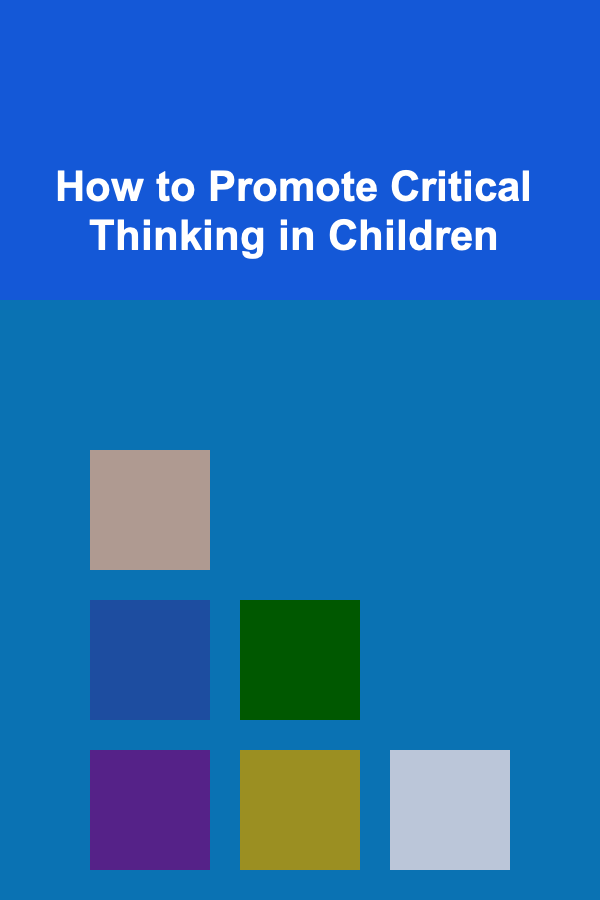
How to Promote Critical Thinking in Children
ebook include PDF & Audio bundle (Micro Guide)
$12.99$7.99
Limited Time Offer! Order within the next:

Critical thinking is one of the most valuable skills children can develop. It helps them make informed decisions, solve problems effectively, and become independent thinkers. In today's fast-paced world, where information is constantly flowing, the ability to evaluate, analyze, and make thoughtful judgments is more important than ever. Encouraging critical thinking in children not only empowers them academically but also helps them grow as thoughtful, responsible individuals.
In this article, we will explore the significance of critical thinking, the role of parents and educators, and practical strategies to foster this essential skill in children.
The Importance of Critical Thinking
Critical thinking involves the ability to think clearly, rationally, and independently. It is the ability to analyze and evaluate information, arguments, and ideas from different perspectives. For children, critical thinking is not just about solving academic problems but also about learning how to approach life's challenges thoughtfully.
Some key benefits of promoting critical thinking in children include:
1. Enhanced Problem-Solving Skills
Children who develop strong critical thinking skills are better equipped to approach problems logically. Instead of reacting impulsively, they can break down problems, evaluate possible solutions, and choose the most effective course of action.
2. Improved Decision-Making
Critical thinking enables children to make well-informed decisions. They can weigh pros and cons, understand the potential consequences of their choices, and consider alternative viewpoints before making a decision.
3. Increased Creativity
When children engage in critical thinking, they learn to think outside the box. They develop the ability to generate multiple ideas, evaluate their feasibility, and come up with creative solutions to problems.
4. Better Communication Skills
Critical thinking helps children articulate their thoughts clearly and persuasively. They can present their arguments logically, ask insightful questions, and engage in meaningful discussions with others.
5. Increased Independence and Confidence
Children who think critically are more confident in their abilities. They are not afraid to question assumptions or challenge traditional ideas. This independence of thought fosters a sense of self-reliance and confidence in their decisions.
The Role of Parents and Educators
Parents and educators play a crucial role in cultivating critical thinking in children. While children are naturally curious, they need guidance and encouragement to develop their cognitive abilities. Both parents and teachers can create environments that stimulate critical thinking and encourage intellectual growth.
1. Creating a Supportive Environment
A supportive environment is essential for critical thinking. Children need to feel safe to express their ideas, ask questions, and make mistakes. Encouragement and positive reinforcement are vital to building a child's confidence in their ability to think critically. Instead of simply providing answers, adults should encourage children to explore different possibilities and solutions.
2. Encouraging Curiosity
Curiosity is the foundation of critical thinking. Parents and teachers should foster a curious mindset by encouraging children to ask questions and explore new concepts. It is essential to create an environment where questions are welcomed, and there is a genuine desire to learn. Asking open-ended questions, such as "What do you think will happen next?" or "How could we solve this problem differently?" can help stimulate critical thinking.
3. Modeling Critical Thinking
Children learn by example. When parents and educators model critical thinking in their own lives, children are more likely to adopt similar approaches. Adults should demonstrate how to evaluate information, consider different perspectives, and arrive at well-thought-out conclusions. This can be done by discussing current events, making decisions together, or reflecting on personal experiences.
4. Providing Opportunities for Exploration
Children need opportunities to think critically through hands-on activities. This could include solving puzzles, playing strategy games, engaging in debates, or participating in group discussions. These activities challenge children to think critically, consider multiple viewpoints, and develop their problem-solving skills.
Practical Strategies for Promoting Critical Thinking in Children
While the importance of critical thinking is clear, it is often challenging for adults to know how to foster it effectively. The following strategies can help parents and educators encourage critical thinking in children at various stages of development.
1. Ask Open-Ended Questions
One of the simplest ways to promote critical thinking is by asking open-ended questions. These types of questions require children to think beyond simple yes or no answers and encourage them to explore their thoughts and reasoning. For example:
- "Why do you think that happened?"
- "What other solutions can you think of?"
- "How would you feel if...?"
- "What evidence do you have to support your idea?"
These questions prompt children to think critically about the situation, consider different angles, and express their reasoning.
2. Encourage Problem-Solving Activities
Problem-solving activities are essential for developing critical thinking. Puzzles, brainteasers, and logic games can help children practice analyzing situations, identifying patterns, and coming up with solutions. These activities help children learn how to approach problems systematically and evaluate possible outcomes.
Some examples of problem-solving activities include:
- Building structures with blocks or LEGO sets
- Solving mazes or riddles
- Playing chess or other strategy games
- Creating and testing experiments in science
These activities also provide opportunities for children to collaborate with others, share ideas, and refine their problem-solving strategies.
3. Teach the Art of Reflection
Reflection is an essential aspect of critical thinking. Encourage children to think about their experiences, actions, and the outcomes of their decisions. This helps children understand what worked, what didn't, and how they can improve in the future. Reflection can be done through discussions, journaling, or simply taking time to think about a situation.
For instance, after completing a task, you can ask:
- "What did you learn from this experience?"
- "If you could do it again, what would you do differently?"
- "How did your decisions impact the outcome?"
Reflection helps children become more self-aware and develop a better understanding of their decision-making process.
4. Foster a Growth Mindset
A growth mindset is the belief that abilities and intelligence can be developed through effort and perseverance. This mindset is essential for critical thinking because it encourages children to embrace challenges, learn from mistakes, and continuously improve. Children with a growth mindset are more likely to take risks, ask questions, and challenge themselves intellectually.
Parents and educators can promote a growth mindset by praising effort rather than innate ability, encouraging resilience in the face of setbacks, and emphasizing the importance of learning from mistakes. For example:
- "You worked really hard on that, and I can see how much you've learned."
- "It's okay to make mistakes. What can we learn from this?"
- "I'm proud of how you kept trying, even when it was tough."
5. Engage in Discussions and Debates
Discussions and debates provide children with the opportunity to express their thoughts, listen to others, and refine their arguments. Engaging in meaningful discussions allows children to evaluate different viewpoints, consider evidence, and communicate their ideas effectively.
Encourage debates on various topics, both academic and personal, that require children to think critically. Topics can range from everyday issues like the pros and cons of technology use to complex matters like environmental sustainability or social justice. Debating helps children articulate their opinions, listen to others, and think on their feet.
6. Incorporate Technology Wisely
In today's digital age, technology can be a valuable tool for promoting critical thinking. However, it's essential to use it mindfully. Instead of relying solely on passive consumption of information (e.g., watching videos or playing games), encourage children to use technology for active learning and problem-solving. Some ways to use technology effectively include:
- Researching topics online and evaluating sources for credibility
- Engaging in educational games that promote strategy and critical thinking
- Participating in virtual discussions or online projects that require collaboration
By using technology thoughtfully, children can enhance their research skills, broaden their perspectives, and apply critical thinking to new contexts.
Conclusion
Promoting critical thinking in children is not just about teaching them to solve problems or make decisions; it's about nurturing their ability to think independently, question assumptions, and evaluate information from multiple perspectives. By creating a supportive environment, asking open-ended questions, engaging in reflective practices, and encouraging problem-solving, parents and educators can help children develop the cognitive tools they need to succeed in both academic and real-world challenges.
Critical thinking is a lifelong skill that will serve children well as they grow into adults. By fostering curiosity, resilience, and a willingness to question and explore, we can prepare children to navigate the complexities of the world with confidence and thoughtfulness.

How to Plan a Fun and Creative Family DIY Fashion Show
Read More
How to Protect Your Home While You're on Vacation
Read More
How to Set Up a Budget-Friendly Organization System
Read More
The Art of Telling Jokes in a Foreign Language: A Deep Dive
Read More
Ask a Feng Shui Expert: Your Questions Answered
Read More
10 Tips for Planning a Surprise Flash Mob Event
Read MoreOther Products

How to Plan a Fun and Creative Family DIY Fashion Show
Read More
How to Protect Your Home While You're on Vacation
Read More
How to Set Up a Budget-Friendly Organization System
Read More
The Art of Telling Jokes in a Foreign Language: A Deep Dive
Read More
Ask a Feng Shui Expert: Your Questions Answered
Read More